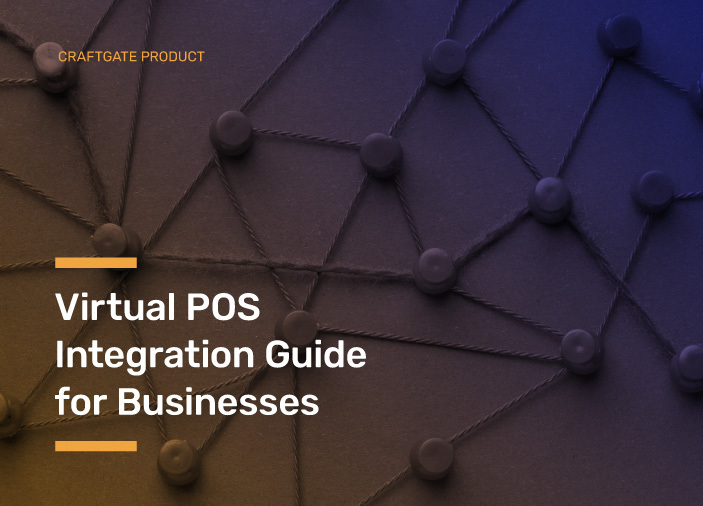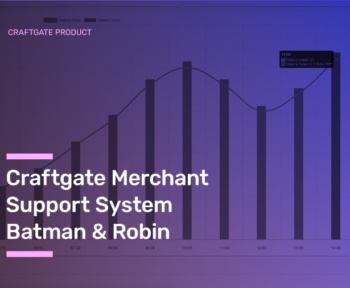
Table of Contents
- What is Virtual POS?
- How to Perform Virtual POS Integration?
- Which Virtual POS Integration is Right for Your Business?
- What is Ready Virtual POS Integration?
- Why Businesses Need Ready Virtual POS Integration?
- Facilities Offered by Craftgate in the Virtual POS Integration Process
- Conclusion
One of the essential steps for businesses looking to present their products or services to customers online is the integration of virtual POS. In this article, we will delve into the details of the virtual POS integration process and provide a detailed overview of how the payment orchestration platform Craftgate facilitates this process for businesses.
What is Virtual POS?
Virtual POS (Point of Sale) systems, the online reflection of physical POS devices, operate on the same principles as physical POS devices used to accept card payments in various locations such as markets, stores, and businesses.
In its simplest form, Virtual POS systems are software that facilitates the payment process. Businesses conducting product or service sales through websites or mobile applications require virtual POS systems to accept payments.

How to Perform Virtual POS Integration?
Businesses wishing to use virtual POS, similar to physical POS devices, must agree with a financial institution. Agreements offered by organizations authorized to provide virtual POS to businesses vary in terms of commission rates and maturity periods.
After completing the contractual processes with the organizations they want to acquire virtual POS, businesses move on to the virtual POS integration step. Unlike physical POS devices, there is no shipment of any physical device at the end of the agreement in the virtual POS integration process. Since virtual POS integration is an entirely online transaction, the software is made accessible and put into use.
Like in virtual POS contract processes, the virtual POS integration process is a technical procedure that varies depending on institutions and businesses.
Which Virtual POS Integration is Right for Your Business?
Research shows that working with a suitable payment method is as essential as providing customers with the right product or service. In this regard, the correct virtual POS integration can be likened to the concept of product-market fit.
There are many parameters to consider for the proper virtual POS integration. Some of the most important ones can be summarized as follows:
- Monthly payment volume passing through the business,
- Customer portfolio,
- Dynamics and characteristics of the market where products or services are offered,
- Location of the desired payment institution, both domestically and internationally.

What is Ready Virtual POS Integration?
While the desire for virtual POS varies depending on the institutions businesses want to obtain it from, individually conducting integration processes with each relevant institution poses an operational burden for companies.
The time-consuming nature of virtual POS integration processes is another critical parameter that businesses should consider. In this regard, ready virtual POS integration offers significant convenience, especially for large-scale or rapidly growing companies.
Many businesses aiming to eliminate the operational burden of the virtual POS integration process benefit from ready integrations through payment gateway products.
According to a survey researching the use of payment gateways in 2023, the United States is the country that benefits the most from payment gateway technology worldwide, followed by Canada, China, and other European countries.
With payment gateway platforms/solutions, businesses can start receiving payments through these institutions without needing a separate integration process after completing the contract stages with the virtual POS or payment institutions they want to work with.
As one of the most critical technologies in the online payment world, payment gateway tools differ from payment orchestration platforms.
Payment orchestration platforms have a structure that includes payment routing mechanisms offering cost advantages, features that increase conversion rates, or solutions providing added value such as Card Storage, Closed Loop Wallet, Payment by Link, and QR Code. One of the solutions they offer is the payment gateway feature.
In summary, a business using a payment orchestration platform can simultaneously benefit from various value-added features, including ready virtual POS integrations.
For more detailed information, you can read our article titled “What is Payment Orchestration?” where we discuss what payment orchestration platforms are and the advantages businesses can gain with these platforms.
Why Businesses Need Ready Virtual POS Integration?
As businesses grow their brand over time, expand their customer base, and increase their monthly payment volume, the need to accept payments with different payment institutions or virtual POS systems arises.
Behind this need typically lies the desire to offer customers different campaigns and installment options, reduce payment expenses by taking advantage of changing commission rates of different payment methods, and diversify payment processes with various payment methods.
For a business wanting to work with different virtual POS or payment institutions, ready virtual POS integration is the most crucial technology that simplifies its life operationally and in terms of time.
A business that does not take advantage of ready virtual POS integration within payment orchestration would need to integrate the systems associated with each virtual POS individually it wants to use. This means managing technical integration processes separately for each payment institution or bank.
At this point, the most significant handicap for businesses is the time-consuming nature of technical integration processes and the operational burden on teams managing these integration processes. Of course, with such a team, this process can be easier.
Considering the points above, ready virtual POS integration significantly benefits businesses that want to work with multiple payment methods.
Facilities Offered by Craftgate in the Virtual POS Integration Process
Let’s emphasize that Craftgate is a payment orchestration platform. It does not provide virtual POS, and it does not have functions for collecting and distributing money. It enables businesses to work with any payment institution they choose, both domestically and internationally, facilitating them to collect payments through the most advantageous methods.
The Craftgate payment orchestration platform offers more than 20 value-added solutions, including the payment gateway feature. The ready virtual POS integration feature within the payment gateway allows our member merchants to collect payments with a single click after entering the information of the affiliated virtual POS into the Craftgate Merchant Panel.
With Craftgate’s Payment Gateway feature, businesses can easily access all payment methods domestically and internationally. After completing the Craftgate integration, they only need to define the information of the affiliated payment institutions through Craftgate.
In summary, to start receiving payments through a new payment method, whether domestically or internationally, businesses can instantly begin collecting payments with a single click without dealing with additional integrations.
Conclusion
In today’s world, where user expectations are shaped by a more effortless and faster technological experience, the same can be said for businesses. Considering the global trend in the use of payment gateway tools, ready virtual POS integration is one of the significant opportunities that meet this need.
To eliminate the operational burden in your business’s virtual POS integration processes and to learn about the advantages you can gain with payment orchestration, feel free to contact us!




